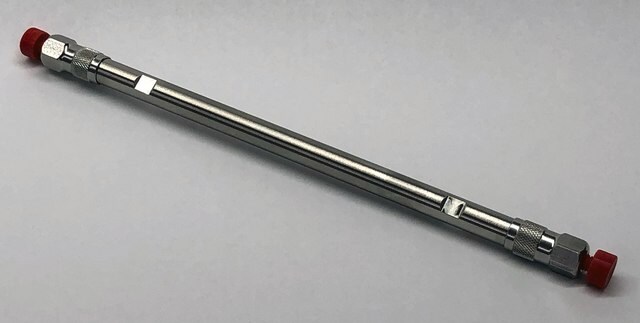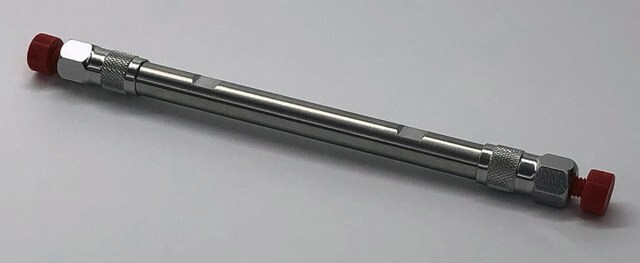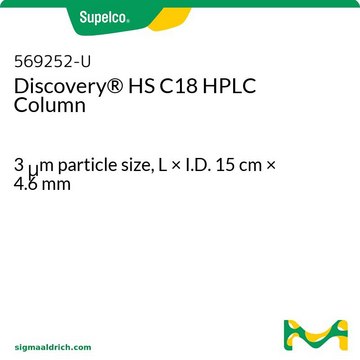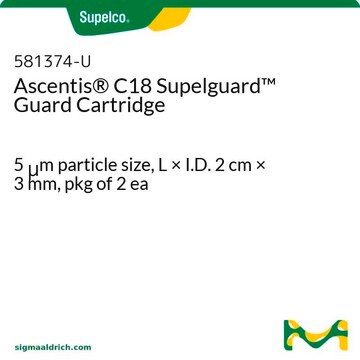Kluczowe dokumenty
581325-U
Ascentis® C18 (5 µm) HPLC Columns
L × I.D. 25 cm × 4.6 mm, HPLC Column
Synonim(y):
Kolumna HPLC Ascentis RP18
About This Item
Polecane produkty
Nazwa produktu
Ascentis® C18 HPLC Column, 5 μm particle size, L × I.D. 25 cm × 4.6 mm
Materiały
stainless steel column
Poziom jakości
agency
suitable for USP L1 (Similar to Phenomenex Luna C18)
linia produktu
Ascentis®
Właściwości
endcapped
producent / nazwa handlowa
Ascentis®
opakowanie
1 ea of
zakres etykietowania
25% Carbon loading
Parametry
≤70 °C temp. range
400 bar pressure (5801 psi)
metody
HPLC: suitable
LC/MS: suitable
dł. × śr. wewn.
25 cm × 4.6 mm
powierzchnia
450 m2/g
pokrycie powierzchni
3.7 μmol/m2
zanieczyszczenia
<5 ppm metals
Matryca
fully porous particle
silica gel high purity, spherical
grupa aktywna macierzy
C18 (octadecyl) phase
wielkość cząstki
5 μm
wielkość porów
100 Å
Zakres roboczy pH
2-8
Zastosowanie
food and beverages
metoda separacji
reversed phase
Szukasz podobnych produktów? Odwiedź Przewodnik dotyczący porównywania produktów
Opis ogólny
Ascentis C18 is an extremely stable and reliable first choice HPLC column that gives symmetric peak shape and excellent retention even for difficult compounds.
Zastosowanie
- Identyfikacja rekombinowanej insuliny ludzkiej i biosyntetycznych analogów insuliny za pomocą multipleksowanej ukierunkowanej nieznakowanej spektrometrii mas proteotypowych peptydów tryptycznych...: W badaniu wykorzystano kolumnę 2445 C18 HPLC do rozdzielania proteotypowych peptydów tryptycznych w identyfikacji analogów insuliny, podkreślając jej zastosowanie w ukierunkowanej spektrometrii mas do analizy proteomicznej (Qasem RJ et al., 2019).
- Opracowanie i walidacja nowej, wskazującej na stabilność metody HPLC do jednoczesnego oznaczania 17-walerianu betametazonu, kwasu fusydynowego, sorbinianu potasu, metyloparabenu i propyloparabenu w preparacie kremu do stosowania miejscowego...: W badaniach tych opracowano i zwalidowano metodę HPLC z wykorzystaniem kolumny 2445 C18 HPLC do jednoczesnego oznaczania wielu związków, wykazując jej solidność w testowaniu stabilności preparatów farmaceutycznych (Byrne J et al., 2014).
- Metody HPLC-DAD i HPLC-ESI-MS/MS do profilowania metabolitów ekstraktów propolisu...: W badaniu zastosowano kolumnę 2445 C18 HPLC do profilowania metabolitów ekstraktów propolisu przy użyciu HPLC-DAD i HPLC-ESI-MS/MS, pokazując jej skuteczność w złożonej analizie produktów naturalnych (Pellati F et al., 2011).
- Praktyczne porównanie cząstek krzemionki o średnicy 2,7 mikrometra z rdzeniem topionym i porowatych cząstek o średnicy poniżej 2 mikrometrów do szybkiej separacji w rozwoju procesów farmaceutycznych...: W tym artykule porównano różne technologie kolumn HPLC, w tym 2445 C18, podkreślając ich wydajność w szybkich separacjach krytycznych dla rozwoju procesów farmaceutycznych (Abrahim A et al., 2010).
Cechy i korzyści
- Excellent retention
- Symmetric peak shape
- High reproducibility
- Complete LC-MS compatibility
Informacje prawne
kartridż do prekolumny
Kod klasy składowania
11 - Combustible Solids
Klasa zagrożenia wodnego (WGK)
nwg
Temperatura zapłonu (°F)
Not applicable
Temperatura zapłonu (°C)
Not applicable
Wybierz jedną z najnowszych wersji:
Masz już ten produkt?
Dokumenty związane z niedawno zakupionymi produktami zostały zamieszczone w Bibliotece dokumentów.
Klienci oglądali również te produkty
Protokoły
-glucoside chloride; Malvidin 3-glucoside; Delphinidin 3-(6-acetylglucoside); Cyanidin 3-(6-acetylglucoside); Petunidin 3-(6-acetylglucoside); Peonidin 3-(6-acetylglucoside); Malvidin 3-(6-acetylglucoside); Malvidin 3-(6-caffeoylglucoside); Petunidin 3-(6-cumarylglucoside); Peonidin 3-(6-cumarylglucoside); Malvidin 3-(6-cumarylglucoside)
-methylcarbamate 10 μg/mL; Diuron; Propham; Siduron; Methiocarb, analytical standard; Linuron 10 μg/mL; Swep 10 μg/mL; Chlorpropham 10 μg/mL; Barban; Neburon
Nasz zespół naukowców ma doświadczenie we wszystkich obszarach badań, w tym w naukach przyrodniczych, materiałoznawstwie, syntezie chemicznej, chromatografii, analityce i wielu innych dziedzinach.
Skontaktuj się z zespołem ds. pomocy technicznej








